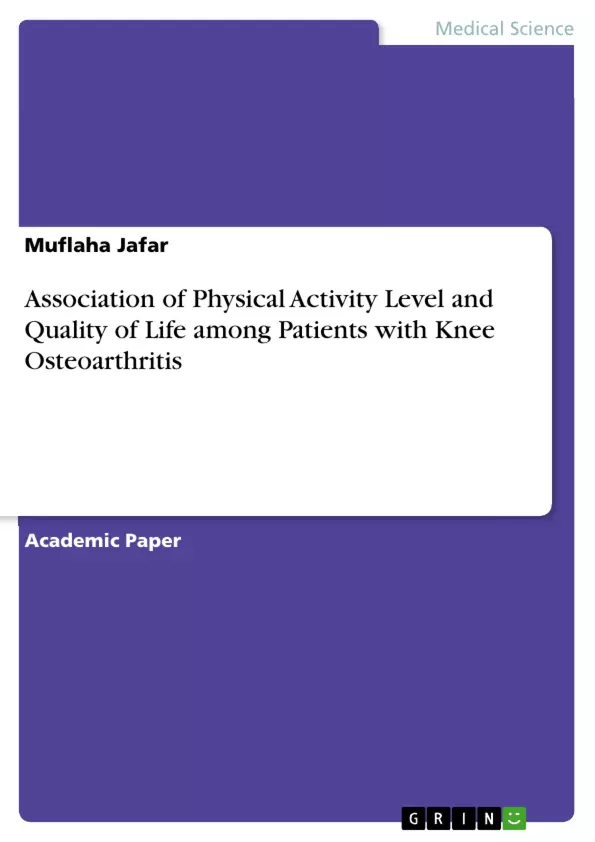The most common form of arthritis is knee osteoarthritis, which is also referred to as wear-and-tear arthritis or degenerative arthritis. Most of the time, synovitis, subchondral bone loss, and osteoarthritis in the knees are the major signs of disease. Mechanical stress, inflammation, biochemical factors, hormonal changes, and getting older can all make knee osteoarthritis worse. The objective of this study is, to find the association of physical activity level and quality of life of the patients suffering from knee osteoarthritis.
The analytical cross-sectional study approach was employed in the research. The group consisted of 278 persons with knee osteoarthritis out of them, few patients who satisfied the inclusion and exclusion criteria were recruited for the study. The research used the non-probability convenience selection approach. Information was received from private clinics, Services Hospital, and the Indus Hospital. The health-related quality of life was measured by SF36, while the physical activity level was measured using IPAQ.
The present study has a positive finding that physical activity has an association with the quality of life in the knee osteoarthritis patient population. Nevertheless, such gross summary scores do not show its relation to general health, energy or fatigue based on IPAQ scores.
Inhaltsverzeichnis (Table of Contents)
- ABSTRACT
- INTRODUCTION
- LITERATURE REVIEW
- OBJECTIVE
- HYPOTHESIS
- Null hypothesis
- Alternative hypothesis
- MATERIALS AND METHODS
- Study design
- Advantages
- Disadvantages
- Settings
- Sample Size
- Sampling technique
- Advantages
- Disadvantages
- Study Duration
- Sample selection criteria
- Inclusion criteria
- Exclusion criteria
- Variables
- Dependent variable
- Independent variable
- Operational Definitions
- Knee Osteoarthritis
- Physical activity level
- Quality of life
- Outcome Measure Tool(s)
- IPAQ (International Physical Activity Questionnaire)
- Sf-36 (ShortForm-36)
- Statistical Analysis
- Study design
- RESULTS
- Distribution of Age
- Distribution of Gender
- Distribution of Weight
- Distribution of Height
- Distribution of BMI
- Association of IPAQ with GENERAL HEALTH
- Association of IPAQ with PHYSICAL FUNCTIONING
- Association of IPAQ with ROLE OF LIMITATION DUE TO PHYSICAL HEALTH
- Association of IPAQ with ROLE OF LIMITATION DUE TO EMOTIONAL PROBLEM
- Association of IPAQ with ENERGY/FATIGUE
- Association of IPAQ with EMOTIONAL WELLBEING
- Association of IPAQ with SOCIAL FUNCTIONING
- Association of IPAQ with PAIN
- Association of IPAQ with Sf-36
- DISCUSSION
Zielsetzung und Themenschwerpunkte (Objectives and Key Themes)
The study aims to investigate the association between physical activity levels and quality of life in patients with knee osteoarthritis. It seeks to explore how physical activity impacts different aspects of quality of life, such as physical functioning, emotional well-being, and social functioning.
- Impact of physical activity on quality of life in knee osteoarthritis patients
- Association between physical activity levels and various domains of quality of life
- Exploring the relationship between physical activity and health outcomes in knee osteoarthritis patients
- Investigating the role of physical activity in improving overall well-being in individuals with knee osteoarthritis
Zusammenfassung der Kapitel (Chapter Summaries)
The study begins with an introduction outlining the prevalence of knee osteoarthritis and its impact on quality of life. The literature review section delves into existing research on physical activity and its association with quality of life in individuals with knee osteoarthritis. The study's objective and hypotheses are then stated, followed by a detailed description of the materials and methods used. This includes the study design, setting, sample size, sampling technique, and variables. Operational definitions for key terms such as knee osteoarthritis, physical activity level, and quality of life are provided. The outcome measure tools used, IPAQ and Sf-36, are also explained. The results section presents the findings of the study, including descriptive statistics on the sample population and analyses of the association between IPAQ scores and various aspects of quality of life measured by the Sf-36. This section outlines the statistical methods employed to analyze the data.
Schlüsselwörter (Keywords)
Knee osteoarthritis, physical activity, quality of life, IPAQ, Sf-36, health outcomes, well-being, functional limitations, emotional distress, social functioning.
- Citation du texte
- Muflaha Jafar (Auteur), 2024, Association of Physical Activity Level and Quality of Life among Patients with Knee Osteoarthritis, Munich, GRIN Verlag, https://www.grin.com/document/1490482



